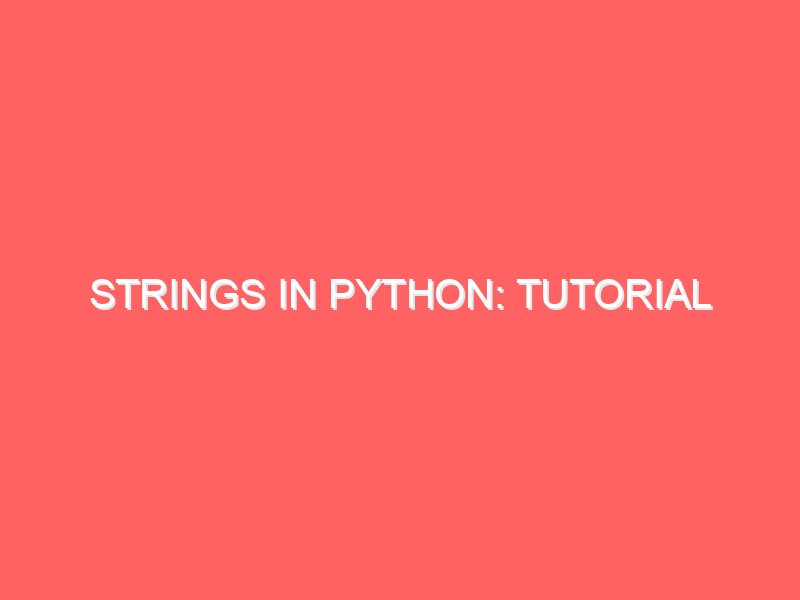Hey there, Python enthusiasts! Ready to dive into the world of strings in Python? Let’s take this journey together, one step at a time, and explore the ins and outs of strings with some fun facts, practical examples, and a few myths busted along the way.
What Exactly is a String?
Imagine you’re writing a message to a friend. Every letter, space, and punctuation mark in that message forms a string. In Python, a string is a sequence of characters enclosed within quotes. You can use single ('), double ("), or even triple quotes (''' or """). Here’s how it looks:
# Single and double quotes
message = 'Hello, Python!'
greeting = "Hi there!"
# Triple quotes for multi-line strings
long_message = '''This is a
multi-line string in Python.'''String Methods: Your Toolbox for Text Manipulation
Strings in Python come packed with a variety of methods that make text manipulation a breeze. Let’s check out some of these handy methods:
upper()andlower(): Convert the case of your string.
text = "Hello, World!"
print(text.upper()) # Outputs: HELLO, WORLD!
print(text.lower()) # Outputs: hello, world!strip(): Remove whitespace from the beginning and end of a string.
text = " Trim me! "
print(text.strip()) # Outputs: Trim me!replace(): Replace parts of your string.
text = "I love Java"
print(text.replace("Java", "Python")) # Outputs: I love Pythonsplit(): Break a string into a list of substrings.
text = "apple,banana,cherry"
fruits = text.split(",")
print(fruits) # Outputs: ['apple', 'banana', 'cherry']Fun Facts About Strings
- Immutability: Strings in Python are immutable. Once created, you can’t change a string. But you can create a new string based on operations applied to the original.
text = "immutable"
text[0] = "I" # This will raise an error- Concatenation and Repetition: You can combine strings using the
+operator and repeat them using the*operator.
part1 = "Hello"
part2 = "World"
print(part1 + " " + part2) # Outputs: Hello World
print(part1 * 3) # Outputs: HelloHelloHelloBusted Myths
- Myth: You need to declare the type of a string.
Fact: Python is dynamically typed, so you don’t need to declare the type explicitly.
my_string = "Just a string"- Myth: Triple quotes are only for comments.
Fact: Triple quotes are great for multi-line strings, not just comments.
multi_line = """This is a string
that spans multiple lines."""A Peek Under the Hood: String Internal Architecture
Python strings are sequences of Unicode characters, which means they can store text in any language. Internally, Python uses an array of characters to store a string, and thanks to immutability, every operation that modifies a string creates a new one.
Memory Efficiency with Interning
Python uses a technique called string interning to save memory for strings that are frequently used. When you create a string, Python might reuse an existing one from memory instead of creating a new one. This is especially common with short strings and literals.
a = "hello"
b = "hello"
print(a is b) # Outputs: True, because of interningDeep Dive: Advanced String Operations
Let’s explore some advanced operations that you might find useful.
Slicing and Dicing
You can extract parts of a string using slicing. It’s like cutting out pieces of a text.
text = "Python is fun!"
print(text[0:6]) # Outputs: Python
print(text[7:]) # Outputs: is fun!
print(text[-4:]) # Outputs: fun!String Formatting
String formatting in Python allows you to inject variables into your strings, making them more dynamic and versatile.
Using format()
name = "Alice"
age = 25
greeting = "My name is {} and I am {} years old.".format(name, age)
print(greeting) # Outputs: My name is Alice and I am 25 years old.Using f-strings (Python 3.6+)
name = "Bob"
age = 30
greeting = f"My name is {name} and I am {age} years old."
print(greeting) # Outputs: My name is Bob and I am 30 years old.Conclusion
And there you have it—a whirlwind tour of strings in Python! From basic manipulations to peeking under the hood, we’ve covered a lot of ground. Remember, strings are more than just text; they are powerful tools that can make your coding life easier and more enjoyable.
So next time you work with text in Python, you’ll know exactly how to handle it with confidence and flair. Happy coding!



